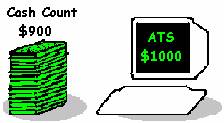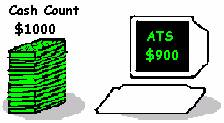Appendix 5 – Tracking Down a Shortage/Overage
Before going further, it is always best to recount the Vault first. If possible, have another teller count the Vault and see if the values match.
Tracking down a VAULT SHORTAGE
A Shortage means the counted value of the Vault (Cash Count) is less than the system’s computed value (Cash @ Close).

One of three possibilities can cause a shortage.
- A transaction that pays cash out was not entered into the system, or the amount was too small. Some examples are transferring inventory from Vault to Teller, or from Vault to Bank.
- A transaction that increases the drawer value was double entered, or the amount was too large. Transfers from Bank to Vault or from Teller to Vault are examples of these.
- The Cash @ Open was incorrect— the actual inventory value was too small.
Tracking down a VAULT OVERAGE
An Overage means the counted value of the Vault (Cash Count) is greater than the system’s computed value (Cash @ Close).

One of three possibilities can cause an overage.
- A transaction that increases the Vault value was not entered into the system, or the amount was too small. Transfers from Bank to Vault or from Teller to Vault are examples of these.
- A transaction that pays cash out was double entered, or the amount was too large. Some examples are transferring inventory from Vault to Teller, or from Vault to Bank.
- The Cash @ Open was incorrect— the actual inventory value was too large.
Tracking down a DRAWER SHORTAGE
A Shortage means the counted value of the drawer (Cash Count) is less than the system’s computed value (Cash @ Close).

One of three possibilities can cause a shortage.
- A transaction that pays cash out was not entered into the system, or the amount was too small. Some examples would be cashing a check, or a Teller to Vault transfer.
- A transaction that increases the drawer value was double entered, or the amount was too large. Bill Payments, Money Orders, and Vault to Teller transfers all bring cash into the Teller Drawer.
- The Cash @ Open was incorrect— the actual inventory value was too small.
Tracking down a DRAWER OVERAGE
An Overage means the counted value of the drawer (Cash Count) is greater than the system’s computed value (Cash @ Close).

One of three possibilities can cause an overage.
- A transaction that increases the drawer value was not entered into the system, or the amount was too small. Bill Payments, Money Orders, and Vault to Teller transfers all bring cash into the Teller Drawer.
- A transaction that pays cash out was double entered, or the amount was too large. Some examples would be cashing a check, or a teller to vault transfer.
- The Cash @ Open was incorrect— the actual inventory value was too large.
Return to ATS Home




